| Years in Russia: | 1761 1762 1763 1764 1765 1766 1767 |
| Centuries: | 17th century · 18th century · 19th century |
| Decades: | 1730s 1740s 1750s 1760s 1770s 1780s 1790s |
| Years: | 1761 1762 1763 1764 1765 1766 1767 |

Events from the year 1764 in Russia
| Years in Russia: | 1761 1762 1763 1764 1765 1766 1767 |
| Centuries: | 17th century · 18th century · 19th century |
| Decades: | 1730s 1740s 1750s 1760s 1770s 1780s 1790s |
| Years: | 1761 1762 1763 1764 1765 1766 1767 |

Events from the year 1764 in Russia
| | This section needs expansion. You can help by adding to it. (October 2015) |
| | This section needs expansion. You can help by adding to it. (October 2015) |
| | This section needs expansion. You can help by adding to it. (October 2015) |
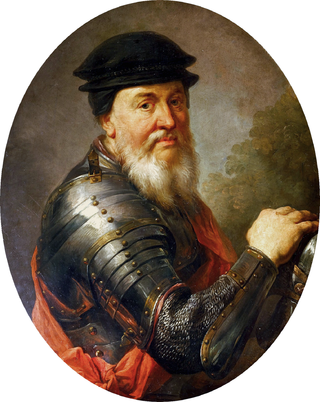
Hetman is a political title from Central and Eastern Europe, historically assigned to military commanders. Used by the Czechs in Bohemia since the 15th century, it was the title of the second-highest military commander in the Crown of the Kingdom of Poland and the Grand Duchy of Lithuania from the 16th to 18th centuries. Throughout much of the history of Romania and the Moldavia, hetmans were the second-highest army rank. In the modern Czech Republic, the title is used for regional governors.
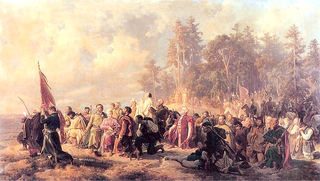
The Bar Confederation was an association of Polish nobles (szlachta) formed at the fortress of Bar in Podolia, now part of Ukraine, in 1768 to defend the internal and external independence of the Polish–Lithuanian Commonwealth against Russian political influence and against King Stanislaus II Augustus with Polish reformers, who were attempting to limit the power of the Commonwealth's wealthy magnates.

The Constitution of 3 May 1791, titled the Governance Act, was a constitution adopted by the Great Sejm for the Polish–Lithuanian Commonwealth, a dual monarchy comprising the Crown of the Kingdom of Poland and the Grand Duchy of Lithuania. The Constitution was designed to correct the Commonwealth's political flaws. It had been preceded by a period of agitation for—and gradual introduction of—reforms, beginning with the Convocation Sejm of 1764 and the ensuing election that year of Stanisław August Poniatowski, the Commonwealth's last king. It's the second constitution in history, after that of the United States.

The Smolny Institute is a Palladian edifice in Saint Petersburg that has played a major part in the history of Russia.

The Russian Academy of Arts, informally known as the Saint Petersburg Academy of Arts, was an art academy in Saint Petersburg, founded in 1757 by the founder of the Imperial Moscow University Ivan Shuvalov under the name Academy of the Three Noblest Arts. Elizabeth of Russia renamed it the Imperial Academy of Arts and commissioned a new building, completed 25 years later in 1789 by the Neva River. The academy promoted the neoclassical style and technique, and sent its promising students to European capitals for further study. Training at the academy was virtually required for artists to make successful careers.
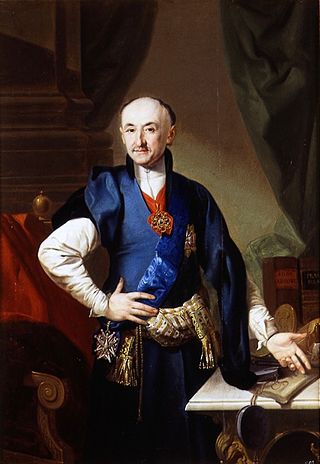
Jacek Małachowski, of the Nałęcz coat-of-arms (1737–1821) was a Polish nobleman, politician and administrator as well as Polish chancellor.
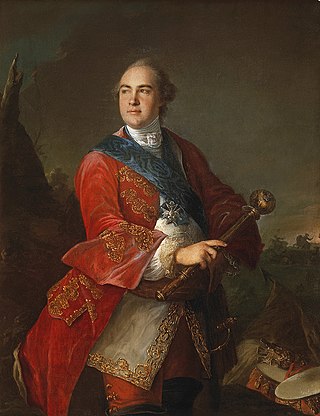
Count Kirill Grigoryevich Razumovski (Razumovsky), anglicized as Cyril Grigoryevich Razumovski (Russian: Кирилл Григорьевич Разумовский, Ukrainian: Кирило Григорович Розумовський, romanized: Kyrylo Hryhorovych Rozumovskyi; 18 March 1728 – 1 January 1803) was a Russian Imperial statesman of Ukrainian Cossack descent, who served as the last Hetman of Zaporozhian Host on both sides of the Dnieper (from 1750 until 1764) and then as a Field marshal in the Russian Imperial Army. Razumovsky was the President of the St. Petersburg Imperial Academy of Sciences from 1746 until 1798.

Slavo-Serbia or Slaveno-Serbia was a territory of Imperial Russia from 1753 to 1764. It was located to the south of the Donets River, between the Bakhmutka River and Luhan River. This area today is located within present-day Luhansk Oblast and Donetsk Oblast of Ukraine. The administrative centre of Slavo-Serbia was Bakhmut.
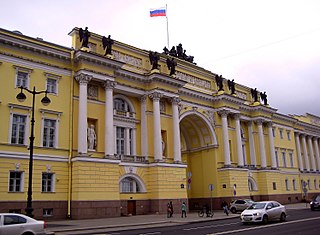
The Governing Senate was the highest legislative, judicial, and executive body subordinate to the Russian emperors, instituted by Peter the Great to replace the Boyar Duma and lasted until the very end of the Russian Empire. It was chaired by the Procurator General, who served as the link between the sovereign and the Senate; he acted, in the emperor's own words, as "the sovereign's eye".
Stepan Gavrilovich Malygin was a Russian Arctic explorer.


Novorossiya Governorate, was a governorate of the Russian Empire in the previously Ottoman and Cossack territories, that existed from 1764 until the 1783 administrative reform. It was created and governed according to the "Plan for the Colonization of New Russia Governorate" issued by the Russian Senate. It became the first region in Russia where Catherine the Great allowed foreign Jews to settle.

The history of the Polish–Lithuanian Commonwealth (1569–1648) covers a period in the history of Poland and Lithuania, before their joint state was subjected to devastating wars in the middle of the 17th century. The Union of Lublin of 1569 established the Polish–Lithuanian Commonwealth, a more closely unified federal state, replacing the previously existing personal union of the two countries. The Union was largely run by the Polish and increasingly Polonized Lithuanian and Ruthenian nobility, through the system of the central parliament and local assemblies, but from 1573 led by elected kings. The formal rule of the nobility, which was a much greater proportion of the population than in other European countries, constituted a sophisticated early democratic system, in contrast to the absolute monarchies prevalent at that time in the rest of Europe.

The History of the Polish–Lithuanian Commonwealth (1764–1795) is concerned with the final decades of existence of the Polish–Lithuanian Commonwealth. The period, during which the declining state pursued wide-ranging reforms and was subjected to three partitions by the neighboring powers, coincides with the election and reign of the federation's last king, Stanisław August Poniatowski.
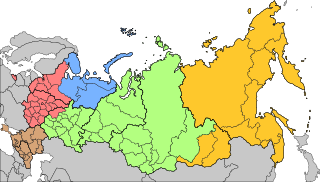
The military districts in Russia serve as administrative divisions for the Russian Armed Forces. Each has a headquarters administering the military formations within the Russian federal subjects that it includes.

Events from the year 1812 in France

Irkutsk Governorate was an administrative division of the Russian Empire, located in Siberia. It existed from 1764 to 1926; its seat was in the city of Irkutsk.

The First Little Russia Governorate or Government of Malorossiya was created by Russian authorities in 1764–65 after the abolition of Cossack Hetmanate in Ukrainian lands incorporated into the Russian Empire. The (First) Little Russia Governorate was governed by Pyotr Rumyantsev.
Events from the year 1740 in Russia
Events from the year 1714 in Russia
![]() Media related to 1764 in Russia at Wikimedia Commons
Media related to 1764 in Russia at Wikimedia Commons